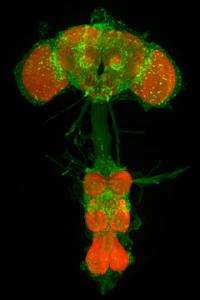Study of fruit fly sleep reveals a genetic basis of insomnia

(Medical Xpress) -- On the surface, it’s simple: when night falls, our bodies get sleepy. But behind the scenes, a series of complex molecular events, controlled by our genes, is hard at work to make us groggy. Now, research suggests that a newly identified gene known as insomniac is an important reason why we don’t stay up all night. By cloning and testing this gene in fruit flies, Rockefeller University researchers say they have discovered an entirely new mechanism by which sleep is regulated.
Nicholas Stavropoulos, a postdoc, and Michael W. Young, Richard and Jeanne Fisher Professor and head of the Laboratory of Genetics, conducted a genetic screen of approximately 21,000 fruit flies. Using a device that employs infrared beams to detect when the flies nod off, they discovered that a specific mutation in the insomniac gene was associated with a dramatic reduction in sleep. While a typical fruit fly sleeps for average of 927 minutes a day, insomniac flies snoozed for just 317. The mutant flies also slept for shorter periods of time, and slept and woke more frequently.
“The results showed a dramatic loss of both the duration of the flies’ sleep and their ability to remain asleep after they dozed off,” says Stavropoulos. “But what’s especially interesting is that the insomniac gene may function through homeostatic mechanisms. These are distinct from the well-studied circadian clock pathways linked to sleep, and have an effect on the body regardless of the time of day.”
The scientists believe that insomniac works by engaging a specific series of protein degradation pathways in neurons through a complex known as Cul3. If correct, this would be the first time that a protein degradation pathway, in which specific proteins are eliminated within a cell, has been linked to sleep.
What’s more, the researchers examined the link between sleep and lifespan, finding that flies with mutations to the insomniac gene lived only about two-thirds as long as unaltered flies (other studies have suggested similar effects in both flies and rats that are deprived of sleep). But when the scientists eliminated insomniac only in neurons — allowing it to remain in the rest of the flies’ bodies — this disparity was eliminated; the resulting animals slept poorly but lived just as long.
“This suggests that reduced sleep can be ‘uncoupled’ from reduced lifespan, supporting the idea that some disruptions of sleep do not effect overall health, at least as far as lifespan is concerned,” Stavropoulos says.
Although flies and humans would appear to have little in common when it comes to lifestyle, scientists say that the mechanisms of sleep and wakefulness are likely to be quite similar.
“Sleep is a fundamental behavior in all animals, and it is poorly understood from a scientific standpoint,” says Stavropoulos. “This work gives us several new clues about how sleep is controlled at the molecular level, and could prove useful in understanding and treating sleep disorders.”
More information: insomniac and Cullin-3 Regulate Sleep and Wakefulness in Drosophila, Nicholas Stavropoulos and Michael W. Young, Neuron 72: 964–976 (December 22, 2011). www.cell.com/neuron/abstract/S0896-6273(11)01045-2















